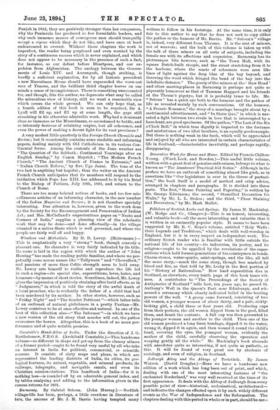Folk - lore of Scottish Lochs and Springs. By James M. Mackinlay.
(W. Hodge and Co, Glasgow.)—This is an honest, interesting, and valuable book—all the more interesting and valuable that it is written in an eminently popular style. It seems to have been suggested by Mr. R. C. Hope's volume, entitled "Holy Wells : their Legends and Traditions," which deals with well-worship in England, but it is in every respect an independent work. The ordinary Scotch reader who is familiar with little outside the national life of his country—its industries, its poetry, and its religion—ought to be appalled by the revelations of the super- stitions which held former generations of his countrymen in bonds. Charm-stones, water-spirits, saint-springs, and the like, all tell the same story,—much the same story, though less marked by blood and fire, as that told by Mr. Lecky in the first portion of his "History of Rationalism." How hard superstition dies in Scotland, as elsewhere, every tenth page of this book bears wit- ness. A contributor to "The Proceedings of the Society of Antiquaries of Scotland" tells how, ten years ago, he passed St. Anthony's Well in the Queen's Park near Edinburgh, and wit- nessed a ceremony which clearly indicated belief in the healing powers of the well. "A group came forward, consisting of two old women, a younger woman of about thirty, and a pale, sickly- looking girl, a child three or four years old. Producing cups from their pockets, the old women dipped them in the pool, filled them, and drank the contents. A full cup was then presented to the younger woman and another to the child. Then one of the old women produced a long linen bandage, clipped it in the water, wrung it, dipped it in again, and then wound it round tile child's head, covering the eyes, the youngest woman, evidently the mother of the child, carefully observing the operation and weeping gently all the while." Mr. Mack inlay's book abounds with anecdotes quite as interesting, if not quite as pathetic, as this. It will be found of very great use by students of sociology, and even of religion, in Scotland.


































 Previous page
Previous page